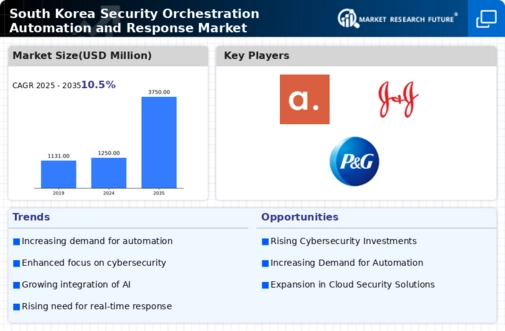Increasing Cyber Threat Landscape
The Global South Korea Security Orchestration Automation and Response Market Industry is experiencing growth due to the escalating cyber threat landscape. As organizations face sophisticated cyberattacks, the demand for advanced security solutions rises. In 2024, the market is projected to reach 1250 USD Million, driven by the need for automated responses to mitigate risks. Companies are increasingly adopting orchestration tools to streamline incident response processes, thereby enhancing their security posture. This trend indicates a shift towards proactive security measures, as businesses recognize the importance of safeguarding sensitive data against evolving threats.
Regulatory Compliance Requirements
Regulatory compliance is a significant driver for the Global South Korea Security Orchestration Automation and Response Market Industry. Organizations are compelled to adhere to stringent regulations regarding data protection and cybersecurity. As compliance requirements become more rigorous, companies are investing in security orchestration solutions to ensure they meet these standards. The market's growth is likely to be fueled by the necessity for continuous monitoring and reporting capabilities, which are essential for compliance. This trend suggests that businesses are prioritizing investments in security technologies to avoid penalties and maintain their reputations in a competitive landscape.
Integration of AI and Machine Learning
The integration of artificial intelligence and machine learning technologies is transforming the Global South Korea Security Orchestration Automation and Response Market Industry. These technologies enhance the capabilities of security solutions, enabling organizations to analyze vast amounts of data and identify threats in real-time. As a result, businesses are increasingly adopting AI-driven orchestration tools to improve incident response times and reduce manual intervention. This trend is expected to contribute to the market's growth, with projections indicating a rise to 3750 USD Million by 2035. The incorporation of AI and machine learning signifies a shift towards more intelligent and adaptive security frameworks.
Growing Demand for Cloud-Based Solutions
The shift towards cloud-based solutions is a prominent driver in the Global South Korea Security Orchestration Automation and Response Market Industry. Organizations are increasingly migrating to cloud environments, necessitating robust security measures to protect their data. Cloud-based orchestration solutions offer scalability, flexibility, and cost-effectiveness, making them attractive to businesses of all sizes. As the market evolves, the demand for cloud-integrated security solutions is likely to grow, reflecting a broader trend towards digital transformation. This shift indicates that organizations are prioritizing security in their cloud strategies, thereby driving the market forward.
Rising Awareness of Cybersecurity Importance
There is a growing awareness of the importance of cybersecurity among organizations, which is significantly influencing the Global South Korea Security Orchestration Automation and Response Market Industry. As cyber threats become more prevalent, businesses are recognizing the need for comprehensive security strategies that include orchestration and automation. This heightened awareness is prompting increased investments in security technologies, as organizations seek to enhance their resilience against potential attacks. The market is expected to witness a compound annual growth rate of 10.5% from 2025 to 2035, indicating a robust commitment to improving cybersecurity measures across various sectors.














Leave a Comment